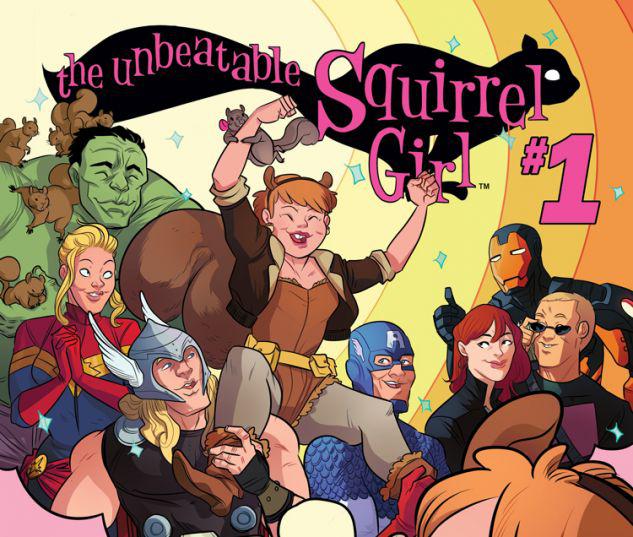Do you like superheroes, but not superhero hype? Do you worry that super-serious superhero films, packed with super-expensive CGI effects and even more expensive actors making sexist PR gaffes, have squashed all the fun out of what ought to be a fun genre—one forever linked to comic books as a medium, or else linked to what were once Saturday morning cartoons? Do you mourn the demise of Saturday morning cartoons, even while recognizing that most of their scripts were terrible? Do you wonder whether the ever-more-elaborate set of Marvel universes, with their infinitely expanding set of Infinity Stones and their cross-platform crossovers, can make fun of itself? Would you like to see a superhero story that entertains ten-year-old readers, their parents, and their unashamed college-age cousins, maybe even for the same reasons? Did you like Felicity? Do you like squirrels?
If you answered “no” to all of those questions, you probably won’t like Marvel’s new comics series The Unbeatable Squirrel Girl. If you answered “yes” to every single one, chances are you’ve already discovered it: Now in its fifth issue (there’s a trade paperback coming this fall), Squirrel Girl has been embraced by savvy readers, and it ought to be a breakout hit. Squirrel Girl herself, created in 1992 by Will Murray and Steve Ditko (co-creator of Spider-Man), but given her very own comic book only this year, is Doreen Green: a chubby-cheeked, awkward, yet preternaturally confident first-year studying computer science at a college that looks a lot like NYU. She “secretly has all the powers of both squirrel and girl.” For example, she has a tail, and talks to squirrels, and they talk back. Doreen’s favorite pet squirrel, Tippy-Toe, came with her to college, though squirrels aren’t allowed in the dorms; Tippy-Toe lives in a nearby tree and gives Squirrel Girl advice.
For example, in Squirrel Girl No. 2, Tippy-Toe warns Squirrel Girl that she’s going to have to travel into space and save the world. “That thing in space!” Tippy-Toe chirps. “It’s gotten closer! Squirrels around the world have been sneaking into observatories to look at it!” Tippy-Toe then pulls out one of Doreen’s collectible Supervillain Trading Cards in order to explain who’s coming: “Galactus the Devourer of Worlds,” who wears a big purple helmet and, yes, eats planets. Earth is now on the menu.
“Get in the purse, Tippy-Toe,” Doreen exclaims, as she rushes off to change into costume. “I guess I’m not joining anime club after all… I’m just gonna have to go kick Galactus’ butt instead!” And that—in the next three issues—is what she does, not through direct confrontation (squirrel powers vs. cosmic force: not a good match) but through the kind of cheerful turning aside of wrath, the playful offering of alternatives, that actual kids are often told to use in playground fights.
What if it worked? What if a positive attitude, a sense of humor, and a big fluffy tail really could get you out of impossible jams? If you’re the unbeatable SG, they can: She seems to know that she’s living not just in a comic book (for there are many kinds of comic books) but in a lighthearted all-ages comic book, where she can accomplish anything she likes as long as an artist can make it look like fun. Except, perhaps, making it to class on time.
And artist Erica Henderson certainly makes Squirrel Girl’s life look fun: She draws everybody—Doreen, her roommate Nancy, Galactus, Iron Man, the squirrels, the spare parts from Iron Man’s metal gloves that Doreen re-engineers to create a mini-spaceship for Tippy-Toe—with the clean curves and soft lines of a goofy family-friendly cartoon. Henderson and writer Ryan North have other kinds of fun, too. Issue No. 4 opens with a page of tweets between @unbeatablesg, Doreen’s roommate @sewwiththeflow, @xGALACTUSx, and @starkmantony (Iron Man, who wants his glove back).
The Unbeatable Squirrel Girl is full of tricks like that, though North and Henderson seem to know that comics can’t depend on them. Comics depend on the story they tell. Squirrel Girl does just what she says she’s going to do, what her motto demands: she’s here to “kick butts and eat nuts… and you can’t eat nuts in space. I mean, you can, but you need, like a special helmet that opens up somehow. And nuts.” (Spoiler alert: Galactus, too, likes eating nuts.)
More than one fan has noted that Squirrel Girl herself looks rounder, shorter and more realistic than many female superheroes, especially when the tail, tucked in, pads her rear end. But realism isn’t the point, though feminism could be: This is a resolutely female-centered, anti-macho book (take that, Jeremy Renner), with all-ages jokes on nearly every page, depicting a streamlined world you might want to visit, especially if you can bring your kids. It’s comic that wants to keep readers smiling: It’s not laughing at superheroes, but laughing with them, even as it reminds us of the extraordinary things they can do.
